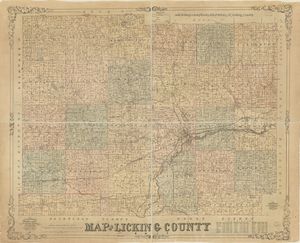History of Licking County
Licking County is located near the geographical center of Ohio. It is divided into 25 townships and contains 5 cities. There are 11 villages and dozens of unincorporated communities. Over the course of time, and due to the development of larger urbanized areas, Licking County is home to many ghost towns as well.
Contents
Prehistory of Licking County
Main article: Prehistory of Licking County
The Prehistory of the county dates back nearly 14,000 years when the last Ice Age began to end and the climate began to get warmer, bringing animals and humans to populate the area. The Mound Builders were some of the first people to more permanently settle the area.
Early Settlement and Development
Before it was settled, Licking County was home to a paradise of wild fruits, berries, trees, and big game. The county was named for the Licking River which is attributed to the salt licks near the banks of the river that brought deer and buffalo to the area, and subsequently people, following the herds. [1] Two of its earliest settlers, Elias Hughes and John Ratliff brought their families to settle in the Bowling Green region, four miles to the east of present day Newark in 1798. [2] Throughout the county, the eastern half was rough and slightly mountainous, while the western half was laid with gently rolling hills. There was diversified plant life which included walnut, sycamore, hickory, ash, elm and cherry trees littered throughout the county. Buffaloes were known to roam the area until it became too populated, and the last one was seen in 1803. Isaac Stadden was another early settler who came from Pennsylvania in 1800. The first trading post was also built in 1800 by Captain Samuel Elliott so he could trade with the Native Americans in the area. By 1800 there were eight families that resided in Licking County. The first cabin in Newark was erected by James Black on the spot where the Warden Hotel once stood, originally called Black's Tavern. [3]
The city of Newark was laid out by John Burnet, John Cumming and George Burnet in 1802. The surveying and the documentation was done by William C. Schenck which was filed on March 18th, 1803. Newark was the first permanent settlement in Licking County, named after Newark, New Jersey, where Schenck was from. Licking County was established in 1808 with Newark as the county's seat, and officially incorporated under the State of Ohio in 1833. [4] The county was primarily agricultural for the first 100 years. From 1802 to 1810, Newark's population was around 200 people, scattered with log cabins through the town. The population continued to grow exponentially, and by 1900 the town had a population of 18,157 people.Construction of the Ohio Canal began in 1825 near present day Heath, significantly began to industrialize the county, and was completed in 1833. [4]
Early manufacturing efforts in Licking County were begun by the Newark Machine Works, established in 1850, which manufactured portable engines and saw mills until the outbreak of the Civil War. Other strong manufacturing production came from the Wehrle Stove Company, the E.H. Everett Glass Works and the Heisey Glass Company. In 1871, the Baltimore and Ohio Railroad headquartered its stops in Newark, making it the largest shops on the route west of the Allegheny Mountains.
Buckeye Lake Park was built in 1910 which became a popular leisure destination and brought a number of tourists to the area before it closed in 1972. [4]
Licking County Bicentennial
Main article: Bicentennial 1808-2008
Licking County's bicentennial was celebrated in 2008. Many events and activities were arranged so citizens could celebrate 200 years of history in Licking County.
References
- ↑ Alrutz, R. (Winter 1993). How Licking County Got Its Name. The Historical Times, 1-1.
- ↑ Hall, L. (1983, October 23). On land where buffaloes once roamed, early settlers founded town of Newark. The Newark Advocate, p. 1D.
- ↑ The Founding of Licking County. (1924, February 6).
- ↑ 4.0 4.1 4.2 Rutter, C. (2008, January 1). A Brief History of Licking County. Retrieved March 27, 2015.
